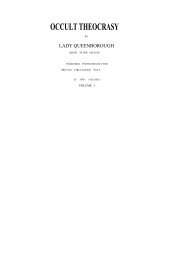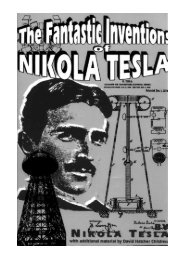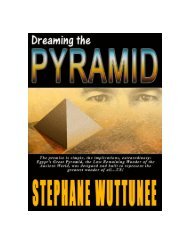the fantastic inventions of nikola tesla - Exopolitics Hong Kong
the fantastic inventions of nikola tesla - Exopolitics Hong Kong
the fantastic inventions of nikola tesla - Exopolitics Hong Kong
Create successful ePaper yourself
Turn your PDF publications into a flip-book with our unique Google optimized e-Paper software.
To whatever extent <strong>the</strong> aluminium tube performs <strong>the</strong> function <strong>of</strong> a screen, its usefulness is <strong>the</strong>refore limited to very<br />
high degrees <strong>of</strong> exhaustion when it is insulated from <strong>the</strong> electrode—that is, when <strong>the</strong> gas as a whole is nonconducting.<br />
-and <strong>the</strong> molecules, or atoms, act as independent carriers <strong>of</strong> electric charges.<br />
In addition to acting as a more or less effective screen, in <strong>the</strong> true meaning <strong>of</strong> <strong>the</strong> word, <strong>the</strong> conducting tube or coating<br />
may also act, by reason <strong>of</strong> its conductivity, as a sort <strong>of</strong> equalizer or dampener <strong>of</strong> <strong>the</strong> bombardment against <strong>the</strong><br />
stem. To be explicit, I assume <strong>the</strong> action as follows: Suppose a rhythmical bombardment to occur against <strong>the</strong> conducting<br />
tube by reason <strong>of</strong> its imperfect action as a screen, it certainly must happen that some molecules, or atoms,<br />
strike <strong>the</strong> tube sooner than o<strong>the</strong>rs. Those which come first in contact with it give up <strong>the</strong>ir superfluous charge and<br />
<strong>the</strong> tube is electrified, <strong>the</strong> electrification instantly spreading over its surface. But this must diminish <strong>the</strong> energy lost<br />
in <strong>the</strong> bombardment for two reasons: first, <strong>the</strong> charge given up by <strong>the</strong> atoms spreads over a great area, and hence<br />
<strong>the</strong> electric density at any point is small, and <strong>the</strong> atoms are repelled with less energy than <strong>the</strong>y would be if <strong>the</strong>y<br />
would strike against a good insulator; secondly, as <strong>the</strong> tube is electrified by <strong>the</strong> atoms which first come in contact<br />
with it, <strong>the</strong> progress <strong>of</strong> <strong>the</strong> following atoms against <strong>the</strong> tube is more or less checked by <strong>the</strong> repulsion which <strong>the</strong><br />
electrified tube must exert upon <strong>the</strong> similarly electrified atoms. This repulsion may perhaps be sufficient to prevent<br />
a large portion <strong>of</strong> <strong>the</strong> atoms from striking <strong>the</strong> tube, but at any rate it must diminish <strong>the</strong> energy <strong>of</strong> <strong>the</strong>ir impact. It is<br />
clear that when <strong>the</strong> exhaustion is very low, and <strong>the</strong> rarefied gas well conducting, nei<strong>the</strong>r <strong>of</strong> <strong>the</strong> above effects can<br />
occur, and, on <strong>the</strong> o<strong>the</strong>r hand, <strong>the</strong> fewer <strong>the</strong> atoms, with <strong>the</strong> greater freedom <strong>the</strong>y move; in o<strong>the</strong>r words, <strong>the</strong> higher<br />
<strong>the</strong> degree <strong>of</strong> exhaustion, up to a limit, <strong>the</strong> more telling will be both <strong>the</strong> effects.<br />
What I have just said may afford an explanation <strong>of</strong> <strong>the</strong> phenomenon observed by Pr<strong>of</strong>. Crookes, namely, that a<br />
discharge through a bulb is established with much greater facility when an insulator than when a conductor is present<br />
in <strong>the</strong> same. In my opinion, <strong>the</strong> conductor acts as a dampener <strong>of</strong> <strong>the</strong> motion <strong>of</strong> <strong>the</strong> atoms in <strong>the</strong> two ways<br />
pointed out; hence, to cause a visible discharge to pass through <strong>the</strong> bulb, a much higher potential is needed if a<br />
conductor, especially <strong>of</strong> much surface, be present. For <strong>the</strong> sake <strong>of</strong> clearness <strong>of</strong> some <strong>of</strong> <strong>the</strong> remarks before made, I<br />
must now refer to Figs. 18, 19 and 20, which illustrate various arrangements with a type <strong>of</strong> bulb most generally<br />
used.<br />
Fig. 18 – BULB WITH<br />
MICA TUBE AND<br />
ALUMINIUM SCREEN<br />
Fig. 19 – IMPROVED<br />
BULBWITH SOCKET<br />
AND SCREEN<br />
Fig. 18 is a section through a spherical bulb L, with <strong>the</strong> glass stem s, containing <strong>the</strong> leading-in wire v, which has a<br />
lamp filament l fastened to it, serving to support <strong>the</strong> refractory button m in <strong>the</strong> centre. If is a sheet <strong>of</strong> thin mica<br />
wound in several layers around <strong>the</strong> stem s, and a is <strong>the</strong> aluminium tube.<br />
Fig. 19 illustrates such a bulb in a somewhat more advanced stage <strong>of</strong> perfection. A metallic tube S is fastened by<br />
means <strong>of</strong> some cement to <strong>the</strong> neck <strong>of</strong> <strong>the</strong> tube. In <strong>the</strong> tube is screwed a plug P, <strong>of</strong> insulating material, in <strong>the</strong> centre<br />
<strong>of</strong> which is fastened a metallic terminal t, for <strong>the</strong> connection to <strong>the</strong> leading-in wire w. This terminal must be well<br />
insulated from <strong>the</strong> metal tube S, <strong>the</strong>refore, if <strong>the</strong> cement used is conducting— and most generally it is sufficiently<br />
so—<strong>the</strong> space between <strong>the</strong> plug P and <strong>the</strong> neck <strong>of</strong> <strong>the</strong> bulb should be filled with some good insulating material, as<br />
mica powder.









